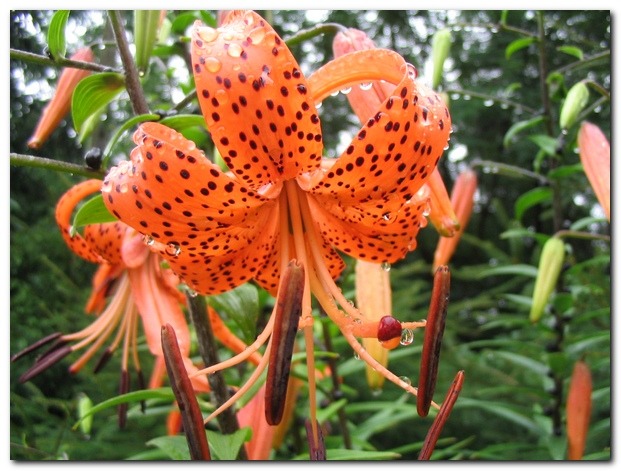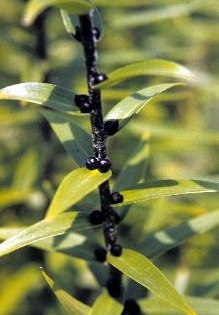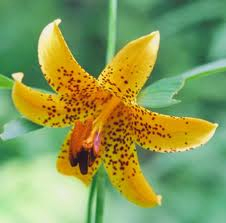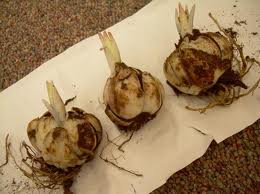The word “lily” causes more confusion than four letters ought to be able to make. There are true lilies, usually not edible, some of them quite toxic, a few edible. And there are plants people call lilies which aren’t lilies at all, some quite toxic and some edible. The next layer of confusion comes from the fact many people call many different plants the same name, in this particular case, the Tiger Lily.
The Tiger Lily we’re interested in for the moment is Lilium lancifolium, a native of Asia and Japan but naturalized in the northeast quadrant of North America, and a few other places as well. Most of this Tiger Lily is edible by humans but all parts are toxic to cats. It causes feline kidney failure. In Asia and Japan this lily is grown for its edible bulb. Cooked it resembles turnips in flavor. Flower buds are eaten raw or cooked.
This particular species does not produce seeds. Instead it produces little black bulbs (bulbils) where the leaves meet the stem. You can use those to propagate the lily or the tubers. However, by bulbil it takes three years for them to mature.
Now we get to the pseudo-controversy. All over the Internet there are dire warnings that the pollen of Lilium lancifolium (aka Lilium tigrinum) is toxic, that is, it will make humans throw up and generally be miserable. Oddly, none of the books in my library, except for one, mentions the pollen at all. Save for that one entry none of my foraging books mention pollen nor do any of my flower books mention it. In fact none of my books on poison mention Lilium lancifolium pollen regarding humans. The one reference I have to the pollen is found on page 512 of the Encyclopedia of Edible Plants of North America by Dr. Françoís Couplan. In reference to Lilium lancifolium and Lilium bulbiferum he writes:
“The pollen can be gathered in relatively important amounts and eaten as such or sprinkled over various dishes. It is nutritious and has a pleasant taste.” The Internet seems to be in disagreement with Dr. Couplan, who has a PhD in ethnobotany. His encyclopedia was published in 1998.
Cornucopia II, which is a compendium of edible plants in the world, also published in 1998, says on page 144 of the Lilium lancifolium: “Flowers both fresh and dried eaten in soups, salads…” No mention of or warning about avoiding the pollen on fresh flowers. It would seem the Internet is at odds with Cornucopia II as well.
The Internet is rife with misstatements. The pollen-is-bad-for-humans warning could have risen out of the real threat it poses to cats. They lick lily pollen off their fur and often die from it. That warning could have morphed from fatal for cats to toxic for humans. There are previous examples with other plants.
Many sites in the last five years have published the warning that pine needle tea can cause abortions in humans, another leap from a known threat animals to certain problem for humans. It started with an article in the Journal of Animal Science (J ANIM SCI 1992, 70:1604-1608.) In the article cows in or after their eighth month of pregnancy which ate several pounds of Ponderosa pine needles did indeed have abortions, the rate ranging from 5 to 8%. Non-pregnant cows were not affected. The article did not cause much alarm as the Internet was in its informational infancy in 1992. However, the United States Department of Agriculture issued a report on the Internet in 2006 — still on line — saying “Ponderosa pine grows in all of the states west of the Great Plains and in western Canada. Pine needles can be made available to cattle from slash remaining after logging operations, windfalls, or dried fallen needles. Discarded Christmas trees have been known to cause abortions in cows. Lodgepole pine (P. contorta), common juniper (Juniperus communis), and Monterey cypress (Cupressus macrocarpa) also contain isocupressic acid and may also cause abortions when eaten by cattle.”
One blog that same year mentioned the cow problem then made the leap by saying Native Americans knew long ago what modern scientists had only recently learned about pines needles and abortions. The blog added the element of Indian woman using pine needles for abortions — no reference given. Included in the blog was one additional comment about pines from the ancient Greeks and the warning was born. From there it proliferated over the Internet. Now pine needles cause abortions in humans, each reference becoming obligatory and more dire. Can you intentionally prepare pine needles to somehow affect a pregnancy in humans? Perhaps, though there seems to be no examples in the medical literature. Then again, too much of anything can probably affect a pregnancy, wine comes to mind. Intentionally preparing an intense dose of pine needles is far different than two pine needles sitting in hot water making a pleasant tea with Vitamin C.
In another example other sites have being saying the aril of the Momordia charantia is toxic to kids. It’s nearly 100% lycopene, not exactly a toxic substance. If it is toxic to children then maybe watermelon is, too. Professor Julia Morton, an expert on edible and toxic plants in Florida, wrote extensively about the species many times and never made mention of anything related specifically to children. I can remember finding the original site that said the arils were toxic to kids. Again, no reference was given. Last year I met a breast-feeding mom who ate them and kept right on feeding.
So, is the pollen of the Lilium lancifolium, toxic to humans? The books say nothing bad about it, Dr. Couplan says it tastes good and can be collected in quantity, the Internet says it is toxic to humans. Can we find a way that toxic view could have been proliferated? Yes, the plant is toxic to cats. It is a short leap for amateur writers to include humans. I wrote to Dr. Couplan for his opinion on this. He wrote back saying he has consumed Lilium lancifolium pollen in small amounts with no known bad effects. Dr. Couplan asked for a reference on the purported toxicology of Lilium lancifolium on humans. I could not and cannot provide one because I can’t find one, published that is. As best I can tell it is Internet rumor and one reason why I prefer published references.
Among the native lilies of North America the cooked bulbs of the follow species can be eaten by humans: Lilium canadense, (now rare in some places) Lilium columbianum, Lilium occidentale, Lilium pardalinum, Lilium parvum, Lilum philadelphicum and Lilium superbum. Yes. Superbum (soo-PER-bum) It means superb. Another edible Asian lily is Lilium bulbiferum.
Lilium is dead Latin for the Greek word Lirion, which means lily. Now days they’re called Krinos — meaning lily — which is also a brand of imported Greek food. That said, lilies get around. A few years ago I had the opportunity to visit the Palace of Knossos near Heraklion, Crete. In the museum is the famous “lily” vase, a fresco that dates back 3,500 years. A similar fresco in the same time frame is found on the Greek island of Thera, though it is better known as Santorini. The working theory is the volcanic eruption that essentially destroyed Santorini created a tidal wave that wiped out the Minoans at Heraklion a few hundred miles away. The Minoan civilization never recovered from that disaster. The frescos did.
Lastly, don’t you think it is odd that the plant is called the Tiger Lily not the Jaguar Lily? Jaguar are orange and have spots, orange tigers have stripes. Maybe the Tigris river had something to do with it.
Green Deane’s “Itemized” Plant Profile
IDENTIFICATION: Bulbs widely ovoid, large scales. Stems minutely woolly, purplish, buds usually flat-sided, somewhat triangular in cross section. Leaves scattered, horizontal and drooping at tips; dark purple axillary bulbils; leaves lanceolate, often narrowly so, edges not wavy. Flowers hang down, not fragrant; Turk’s-cap-shaped; sepals and petals curve back, orange with many purple-brown spots; stamens stick out, ends purplish,
TIME OF YEAR: Late summer
ENVIRONMENT: Near damp places in urban areas, roadsides, railroad banks, buildings.
METHOD OF PREPARATION: Bulbs boiled, pickled, or used to make starch. Resemble parsnip in flavor. Flowers both fresh and dried used in soups, salads, omelets and rice dishes.







I need to confirm can we use the Lilium lancifolium bulbs as food or herb ?
The article said they were. Lilium lancifolium bulbs are edible, as are its flowers. Usually the bulbs are boiled, flowers are used fresh or dried.
We ate Tiger Lilies when I was a kid all the time. Just the petals though not the stamen or pollen. Delicious! Light, delicate sweetness – pretty in salads.
Enjoyed your article on lilies. I have lots of them, and am getting started doing upscale Chinese cooking. The info that I looked at previous to yours indicated use of lots of dessicant powders. Possibly for use in dried flower arrangements. Anyhow, didn’t want to eat those. Also assume that 1,000 years ago that wasn’t an available method. Could you address methodology to process these for consumption? Thank you
So, what about other asiatic lilium species, like stargazers? Do you know anything about the edibility of these? They are so common! Any insight would be awesome.
Stargazers are Oriental hybrids, most oriental hybrids don’t have the right taste. Asiatic hybrids are more suitable but I also still looking for the best variety. Batistero and california are varieties still in production.
ps grow them one year yourself before eating because of chemicals used during production
I have harvested Tiger Lily flower pods before they open and have cooked them and butter and garlic for the last 3O years.My children grew up eating the lilies as a side dish. Just saying.
Hi,
I am looking for a great filling for Tiger Lily blossoms do you have one? Thanks,
Lauren Roy
The Modern Pioneer an Almanac of Natural Living
thank you but do you know if tiger lileys at sea leval
Grow at sea level? Yes.
I went to the above website at botanical.com and read the information about tiger lilies. It does say that the pollen is toxic, but it’s important to remember that just because it’s written down somewhere doesn’t make it true. If such was the case Sarah Palin’s collected writings certainly would have doomed the world to all kinds idiocy by now. Unless you plan to collect the pollen in “important amounts” and eat it I doubt it’s worth worrying about. As it is I plan myself to trust the empirical experience of the esteemed ethnobotanist Dr. Couplan and exercise moderation should I choose to consume the pollen, since the information on THIS website as well (where I’m concerned at least) is from the internet itself.
Great article! Thank you! I’ve had tiger lily bulbs in Chinese dishes (real Chinese and not Chinese-American food), and they were delicious. You are certainly right about the Internet being full of fear mongering and misinformation. A classic example is MSG, which has been scientifically proven to be perfectly safe (your own body manufactures large amounts every day), but if you went by the Internet, you would think it would kill you.
do all tiger lilies have bolbils to reproduce?
One could presume that the Lilium lancifolium was not called te ‘jaguar lily” because jaguars are New World animals. 🙂
Also, jaguars have large rosettes, rather than small, solid colored spots. I’ve always wondered why these were not called ‘leopard lilies’.
you can spir in a tissue
Very informative article, thank
you so very much. As a side,
I KNOW that the deer love em
cause unless i spray the flower
pods w stinky stuff we will NOT
get to enjoy the blooms every
year out here in the mid central
boonies of GA. Can the pollen
be used to,say, dye clothing,or
maybe used like henna? Love
and wisdom to all ya’ll.
Greg, MSG is definitely not safe, my husband and I received large amounts from the restaurants we visited years ago without our knowing and now any time we have MSG we are both in the bathroom. wicked stuff!
I agree about the MSG not being safe. I have read studies where the Chinese are experimenting with it for medicinal uses. I think it was liver detoxification? Can’t remember but they also say Soy Bean is good for you and as we all know our digestive tracks are not made to handle Soy Beans. It is because they wanted to feed their masses and so they sold them on Soy. The also do not believe in our Creator and rather believe in Evolution so anything they come up with is bull. MSG is not safe or we would not be cutting it out of our diets and foods. Especially our greedy food manufacturers. There is a reason it was taken out?
Is there anywhere or anyone that has these types of edible lilies available to buy? Definitely want to add them to my edible landscape plans. Tirelessly searched online for any site selling confirmed edible types but can only find one that was out of stock. Definitely want someone who knows for sure the species and it’s edibility. Thanks for any help! Also looking for confirmed edible types of day lily, hostas, and dahlias etc. Hear all hostas are edible but would be nice to find types grown for edibility exclusively to know it will be good edible quality.
What state are you in? You could come dig up a pile out of my yard for free you just got a dig them up and then they’ll grow you can literally just throw the huge root mass anywhere and it’ll grow.. I dug up a bunch this year to make room for more garden threw them against the fence in the shade and they’re still growing. LOL
Their den is 15 feet long.
Tiger lily color (wild plants) is tiger orange.
American Indian aborificants are plants known and avoided while pregnant. No American Indian would recommend them because killing a baby would mean the women in the family would condemn the person to death, with her mother called on as executioner. And, that’s still true after so many decades of forced sterilization–and I’ve heard stories of it happening.
As pine needles are rich in Vitamin C, tea was used in winter, but for women of child bearing age, wine was made in late summer and into the fall, sealed, and stored underground. In the darkness of winter, men assigned by elder women would carry jars of wine to the tops of mountains to freeze overnight, then drained and the resulting brandy carried home for the old folks to enjoy. Men, you had to be of age to be a grandfather to drink more than a mild homebrew. For children, sorry, you’re stuck with pine needle tea. walk in beauty